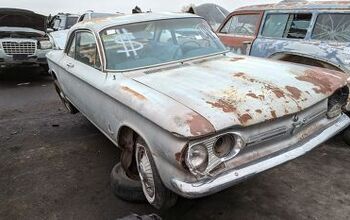In Defense of: The Chevrolet Corvair

Fifty years ago, GM’s engineers and designers worked overtime to create a radical new economy or “compact” car. Its mission: take on the VW Beetle and a host of European imports flooding the U.S. market. The 1960 Chevrolet Corvair flopped in its intended role. Nevertheless, it went on to become one of the single most influential American cars ever made. Its legacy can still be seen around the world.
The Chevrolet Corvair was a space efficient, low-slung compact with a six-cylinder air-cooled engine. The rear engine promised a low center of gravity, light unassisted steering, superb traction and balanced braking– all the same qualities that Porsche had been cultivating successfully for years. Budget-minded American driving enthusiasts were thrilled.
Unfortunately, the design came with intrinsic liabilities: poor heating, a complex (read: expensive) alloy engine, oil leaks and distinctly un-American handling qualities (read: oversteer). It was the last quality that attracted the attention of a consumer crusader named Ralph Nader, who highlighted the Corvair in his seminal tome “Unsafe at any speed.”
The Corvair was not intrinsically unsafe. As long as owners maintained the eleven pound differential between its front (15/19lbs) and rear (26/30lbs) tires, the Corvair’s handling remained friendly and innocuous. But Americans were (and are) not known for monitoring their vehicle’s tire pressure. Gas station attendants of the time had a mantra: “24 pounds all around.” They became unwitting co-conspirators in the Corvair’s fall (spin) from grace.
With incorrect tire pressures, a rapidly cornering Corvair driver could easily find the vehicle’s back end heading towards the front. The average US driver was simply not prepared to handle that eventuality. Could GM have done more to avoid the oversteer stigma? Yes. GM saved six dollars per car by not making the front anti-sway bar standard. And who knows how much (little) the effective rear camber-compensating spring adopted in 1964 cost.
In 1972, the National Highway Traffic Safety Administration issued a report exonerating the Corvair from Nader’s accusations. It arrived too late. Chevrolet had deep-sixed the Corvair seven years earlier. Even without the safety controversy, Chevy knew Ford’s highly conventional Falcon was about to eat their lunch. What’s more, GM’s beancounters had proclaimed that the Corvair was too expensive to make profitably (setting a pattern for small car thinking that continues to this day).
In the fall of 1959, Chevrolet was already cooking up Plan B: the 1962 Chevy II. Utterly conventional (and boring), the bigger Nova was the real anti-Falcon, and the route to compact-car profits. Which left a question: what to do with the Corvair?
The answer was the Corvair’s enduring U.S. legacy: the sporty Monza coupe. The model debuted at the 1960 New York Auto Show, complete with bucket seats, a higher output engine and a four-speed manual transmission. The Monza was an unexpected home run. In 1960, Chevy hastily assembled 14k Monzas. By 1961, the Monza dominated the Corvair line-up, and single-handedly created the market for popular-priced American-made performance cars.
But creating a market is not the same as exploiting it. Lee Iacocca’s seminal Mustang did that. Turbocharging and quad-carb induction couldn’t overcome the little six’s limitations against cheap V8 power. The Chevrolet Camaro was quickly pressed into action.
Meanwhile, the clean, elegant and highly-original 1960 Corvair initiated a styling revolution. In fact, it would be difficult to overstate the Corvair’s impact on European automotive design. Before the Monza, Europe was overdue for a new design lexicon. Even the conceptually-revolutionary 1959 Mini still wore the styling language of the early/mid fifties. The Corvair’s influence on subsequent European small and mid-size cars was unrivaled and unprecedented.
Some were blatant rip-offs: the NSU Prinz/1000, Hillman/Sunbeam Imp, Simca 1000, ZAZ-966, Panhard Dyna Coupe. Others were merely profoundly influenced: Fiat 1500, Lancia Fulvia, VW 1600 L Coupe (“the German Monza”) and a host of other early-mid sixties cars around the globe.
Yes, most of these models were narrower and taller than the Corvair. But the Corvair’s strong, high belt-line crease, its clean and inward curving lower flanks, airy green-house, under-cut front and strong rectilinear lines make its influence easily identifiable– even today.
Take a look a BMW 5-Series. That strong horizontal crease-line running unbroken from front to rear has long been BMW DNA, but it’s a genetic transplant from the Corvair. BMW’s renaissance (and styling DNA) is based on their mid-sixties sedans and coupes, including the popular 2002. Their design elements scream “Corvair”.
The timelessly elegant, superb handling 1965 Chevrolet Corvair was built past the Camaro’s 1967 intro– just so General Motors would not be seen to be buckling-in to Nader and other detractors. But tightening emission and safety standards had sealed its fate; the Corvair died a quiet death in 1969.
Mustangs, Camaros, BMW’s. Not a bad legacy, for such a star-crossed little car.

More by Paul Niedermeyer
Latest Car Reviews
Read moreLatest Product Reviews
Read moreRecent Comments
- Kjhkjlhkjhkljh kljhjkhjklhkjh A prelude is a bad idea. There is already Acura with all the weird sport trims. This will not make back it's R&D money.
- Analoggrotto I don't see a red car here, how blazing stupid are you people?
- Redapple2 Love the wheels
- Redapple2 Good luck to them. They used to make great cars. 510. 240Z, Sentra SE-R. Maxima. Frontier.
- Joe65688619 Under Ghosn they went through the same short-term bottom-line thinking that GM did in the 80s/90s, and they have not recovered say, to their heyday in the 50s and 60s in terms of market share and innovation. Poor design decisions (a CVT in their front-wheel drive "4-Door Sports Car", model overlap in a poorly performing segment (they never needed the Altima AND the Maxima...what they needed was one vehicle with different drivetrain, including hybrid, to compete with the Accord/Camry, and decontenting their vehicles: My 2012 QX56 (I know, not a Nissan, but the same holds for the Armada) had power rear windows in the cargo area that could vent, a glass hatch on the back door that could be opened separate from the whole liftgate (in such a tall vehicle, kinda essential if you have it in a garage and want to load the trunk without having to open the garage door to make room for the lift gate), a nice driver's side folding armrest, and a few other quality-of-life details absent from my 2018 QX80. In a competitive market this attention to detai is can be the differentiator that sell cars. Now they are caught in the middle of the market, competing more with Hyundai and Kia and selling discounted vehicles near the same price points, but losing money on them. They invested also invested a lot in niche platforms. The Leaf was one of the first full EVs, but never really evolved. They misjudged the market - luxury EVs are selling, small budget models not so much. Variable compression engines offering little in terms of real-world power or tech, let a lot of complexity that is leading to higher failure rates. Aside from the Z and GT-R (low volume models), not much forced induction (whether your a fan or not, look at what Honda did with the CR-V and Acura RDX - same chassis, slap a turbo on it, make it nicer inside, and now you can sell it as a semi-premium brand with higher markup). That said, I do believe they retain the technical and engineering capability to do far better. About time management realized they need to make smarter investments and understand their markets better.







































Comments
Join the conversation
Great article. Corvair has always been near the top of my list of best looking cars. Effortlessly elegant. Interesting to learn that it was officially imported into Europe. I've always thought that of all the Detroit cars of the era, the Corvair was the one that would appeal the most to us Euros. @DarkOneForce: As I recall, the ADO16 (Austin/Morris 1100/1300) was styled by Pininfarina? I think the Mini was an Issigonis job though.
I miss my 1961 Corvair Coupe ~ it was a base model , not even a radio although it had the two speed Slip 'N Slide Powerglide transaxle . It's engine was totally worn out but never leaked any oil after I replaced the crappy seals with Viton ones . You had to drive a Corvair to appreciate it's good handling and fun drivability . -Nate